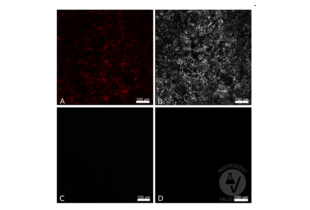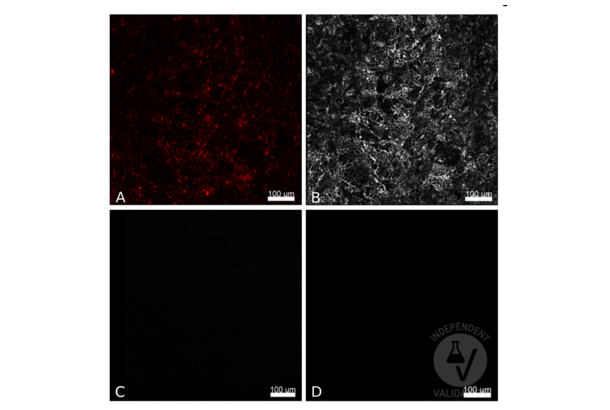RFP Antikörper
- Cellular Localization and Protein Trafficking: Researchers can fuse the RFP protein to their protein of interest. By using an RFP antibody, they can detect the presence and subcellular localization of the fusion protein within cells. This helps in understanding the dynamics and movement of proteins within cellular compartments.
- Gene Expression Studies: RFP can also be used as a marker for gene expression. Researchers can use RFP-tagged constructs to monitor the expression of specific genes. Antibodies against RFP are then used to detect the RFP-tagged protein produced from these genes.
- Protein Interaction Studies: RFP can be used in protein-protein interaction studies. Proteins of interest are tagged with RFP and their interactions with other proteins are investigated. Antibodies against RFP can then be used to detect these interactions either through immunoprecipitation or other methods.
- Live Cell Imaging: RFP-tagged proteins can be imaged in real-time within live cells using fluorescence microscopy. This allows researchers to track protein dynamics, localization changes, and cellular responses in real-time.
- Flow Cytometry: Antibodies against RFP can be used in flow cytometry (FACS) to quantify the expression levels of RFP-tagged proteins in a population of cells. This is particularly useful for high-throughput studies.
- High-Content Screening: RFP antibodies can be used in high-content screening assays to study various cellular processes and responses across large sets of conditions or compounds.
- Visualization of Cellular Structures: RFP can be fused to specific cellular structures such as organelles, cytoskeletal components, or membranes. Antibodies against RFP allow researchers to visualize these structures and their dynamics.
- Co-localization Studies: Antibodies against RFP can be used in combination with antibodies against other fluorescent proteins to study co-localization and potential interactions between different cellular components.

 RFP Antikörper (ABIN129578)
RFP Antikörper (ABIN129578)
RFP Reaktivität: Discosoma WB, ELISA, IF, IHC, IP, FACS, IHC (fro), IHC (p) Wirt: Kaninchen Polyclonal unconjugated
RFP Reaktivität: Discosoma WB, ELISA, IP, FACS, FM Wirt: Maus Monoclonal 8E5-G7 unconjugated
RFP Reaktivität: Discosoma WB, IF, IHC (fro), IHC (p) Wirt: Ziege Polyclonal unconjugated
RFP Antikörper nach Reaktivität
Hier sind RFP Antikörper für eine Vielzahl von Species wie anti-Discosoma RFP zu finden. Die unten aufgeführten Species gehören zu den verfügbaren Arten. Klicken Sie auf einen Link, um zu den entsprechenden Produkten zu gelangen.
RFP Antikörper nach Wirt
Hier sind RFP Antikörper mit einem spezifischen Wirt zu finden. Die hier aufgeführten Wirt sind einige der verfügbaren. Ein Klick auf den entsprechenden Link führt zu den Produkten.
RFP Antikörper nach Bindungsspezifität
Hier sind RFP Antikörper mit einem bestimmten Epitop aufgelistet. Die unten aufgeführten Epitope gehören zu den verfügbaren Epitopen. Klicken Sie auf einen Link, um zu den entsprechenden Produkten zu gelangen.
RFP Antikörper nach Klonalität
Finden Sie verfügbare monoklonale oder polyklonale RFP Antikörper. Klicken Sie auf einen Link, um zu den entsprechenden Produkten zu gelangen.
RFP Antikörper nach Klon
Hier sind RFP Antikörper mit einem spezifischen Klon zu finden. Die hier aufgeführten Klon sind einige der verfügbaren. Ein Klick auf den entsprechenden Link führt zu den Produkten.
RFP Antikörper nach Fragment
Hier sind RFP Antikörper mit einem spezifischen Fragment zu finden. Die hier aufgeführten Fragment sind einige der verfügbaren. Ein Klick auf den entsprechenden Link führt zu den Produkten.
Häufig verwendete RFP Antikörper
- (356)
- (11)
- (1)
- (16)
- (9)
- (2)
- (4)
- (1)
- (1)
- (1)
- (27)
- (3)
- (2)
- (2)
- (2)
- (4)
- (2)
- (1)
- (2)
- (1)
- (1)
- (1)
- (1)
- (1)
- (2)
Aktuelle Publikationen für unsere RFP Antikörper
: "Injury primes mutation-bearing astrocytes for dedifferentiation in later life." in: Current biology : CB, (2023) (PubMed).: "Diet suppresses glioblastoma initiation in mice by maintaining quiescence of mutation-bearing neural stem cells." in: Developmental cell, (2023) (PubMed).
: "Molecular sensing of mechano- and ligand-dependent adhesion GPCR dissociation." in: Nature, Vol. 615, Issue 7954, pp. 945-953, (2023) (PubMed).
: "Overexpression of Lin28A in neural progenitor cells in vivo does not lead to brain tumor formation but results in reduced spine density." in: Acta neuropathologica communications, Vol. 9, Issue 1, pp. 185, (2022) (PubMed).
: "A versatile viral toolkit for functional discovery in the nervous system. ..." in: Cell reports methods, Vol. 2, Issue 6, pp. 100225, (2022) (PubMed).
: "Axon guidance at the spinal cord midline-A live imaging perspective." in: The Journal of comparative neurology, (2021) (PubMed).
: "Gene regulatory networks controlling differentiation, survival, and diversification of hypothalamic Lhx6-expressing GABAergic neurons." in: Communications biology, Vol. 4, Issue 1, pp. 95, (2021) (PubMed).
: "Extrinsic Regulators of mRNA Translation in Developing Brain: Story of WNTs." in: Cells, Vol. 10, Issue 2, (2021) (PubMed).
: "Co-activation of Sonic hedgehog and Wnt signaling in murine retinal precursor cells drives ocular lesions with features of intraocular medulloepithelioma." in: Oncogenesis, Vol. 10, Issue 11, pp. 78, (2021) (PubMed).
: "The white matter is a pro-differentiative niche for glioblastoma." in: Nature communications, Vol. 12, Issue 1, pp. 2184, (2021) (PubMed).
Haben Sie etwas anderes gesucht?
- RFFL Antikörper
- RFC5 Antikörper
- RFC4 Antikörper
- RFC3 Antikörper
- RFC2 Antikörper
- RFC1 Antikörper
- REXO4 Antikörper
- REXO2 Antikörper
- REXO1 Antikörper
- REV3L Antikörper
- REV1 Antikörper
- RETNLB Antikörper
- Retinol-Binding Protein Antikörper
- Retinol Dehydrogenase 5 (11-Cis/9-Cis) Antikörper
- Retinol Dehydrogenase 14 (All-Trans/9-Cis/11-Cis) Antikörper
- Retinol Binding Protein 5 Antikörper
- Retinol Binding Protein 2, Cellular Antikörper
- Retinol Binding Protein 1, Cellular Antikörper
- Retinoid X Receptor, gamma Antikörper
- Retinoid X Receptor, alpha Antikörper
- RFT1 Antikörper
- RFTN1 Antikörper
- RFWD2 Antikörper
- RFWD3 Antikörper
- RFX1 Antikörper
- RFX2 Antikörper
- RFX3 Antikörper
- RFX4 Antikörper
- RFX5 Antikörper
- RFX6 Antikörper
- RFX7 Antikörper
- RFX8 Antikörper
- RFXANK Antikörper
- RFXAP Antikörper
- RG9MTD1 Antikörper
- RG9MTD2 Antikörper
- RG9MTD3 Antikörper
- RGC32 Antikörper
- RGL1 Antikörper
- RGL2 Antikörper




